
Screen shot from video of men building a fish weir near Atka, ca. 1946. Click to see video. Source: http://vilda.alaska.edu/cdm/singleitem/collection/cdmg11/id/37038/rec/36
So, still rustling around the weird world of weirs. The online Alaskan archives have quite a few interesting examples – and, kind of remarkably, a video showing the construction of a weir near Atka, which is on the Aleutian Islands. The trap in the video is pretty similar to a couple of other Aleutian ones in the collection, which I’ll talk about below. It’s really cool to not only see a more-or-less traditional trap being built (look at the rocks being casually dropped down by the wooden fence!) but the photos also show weirs actually in use. There’s probably a lot to learn from these pictures – as any introductory textbook in archaeology will tell you, the more we know about the behavioural context of a given site type, the more we can reliably infer the cultural context when presented only with the archaeological remains.
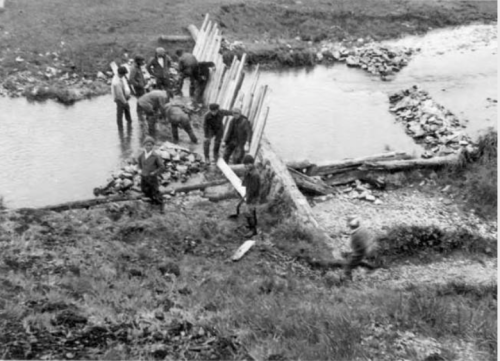
“The Natives have been busy erecting a fish trap” reads the slightly condescending title. Nikolski, Aleutians, ca. 1938. Source: http://vilda.alaska.edu/cdm/singleitem/collection/cdmg13/id/7678/rec/38
In the picture above, it’s interesting to see the reinforcement of the stream banks with rocks (to the left) and with a kind of wood cribbing (to the right). The basis of the wood fence is a solid log spanning the creek, and not a series of tripods or (apparently) stakes driven into the substrate. It’s an interesting method I hadn’t seen before – particularly so since wood is at a premium in the essentially treeless Aleutian environment.

“Natives dividing the fish from the trap. Nikolski, Aleutians”. ca. 1938. Source: http://vilda.alaska.edu/cdm/singleitem/collection/cdmg13/id/7679/rec/39
The same trap features above. You can see the catch being “divided” in the upper part. More importantly, a complete view of the weir is seen. The stream flow is left to right. It’s interesting there is a substantial gap between a wooden fence and a stone weir, creating a kind of pool, but downstream of the wooden elements. At about the 19 second mark of the video, you can dimly see a riffle in the water downstream with some wooden elements, probably a similar double weir design. In the photo, presumably, fish enter through the gap in the stone wall, and then are controlled in their upstream movements by the wooden wall. Perhaps they mill around in that pool and can be harpooned or dip-netted. There’s no sign of an actual trap of any kind in the picture – I would expect to see it if the fish had been dumped out of it. (More on woven traps below). Obviously without the wooden elements you’d have only a dim apprehension of the weir’s operation – and this kind of weir seems designed to leave no wooden traces. Other interesting pictures showing weirs in use include: dipnetting at a weir; another dipnet/basket trap picture , removing salmon from a basket trap into a canoe; Mrs. Huche Jackson cleaning fish at a weir in Yukon; “Athabascan” fisherman in a kayak at a weir; close up of women on a weir (note the huge ? dipnet); and fish trap and drying salmon. Or do your own search.
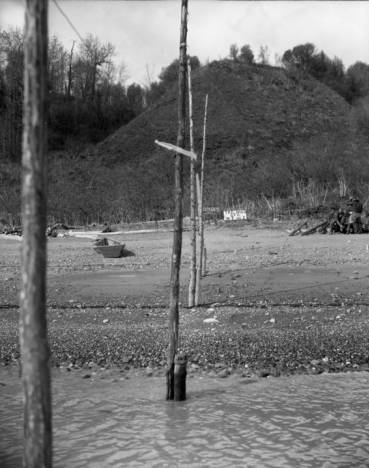
“To show how a ‘hand trap’ was constructed.
Note the stake driven into the beach and the uprights are tied or wired to the stakes at the out or trap end this can only be done at very low tide.” Trading Bay, Cook Inlet, ca 1948. Source: http://vilda.alaska.edu/cdm/singleitem/collection/cdmg2/id/6696/rec/46
River-spanning weirs are not the only kind from this collection at University of Alaska. The above shows stakes driven into intertidal deposits. Interestingly, as the original caption says, the taller posts are wired onto the shorter ones. Whether this is a repair, or a cunning strategy to enable rapid erection of the trap when needed, and low impact on the trap when not assembled, it has implication for all of us out recording stake patterns and dating stake elements. Obviously in the above picture, some sort of planks, matting or loosely woven element is missing, since this part of the trap is a “lead”, designed to gently steer fish into the actual trap element. Long time readers will remember this post, highlighting a poster from Nancy Greene, who has led the detailed recording and analysis of fish trap complexes in Comox Harbour. For example, I previously posted the picture below, from a poster Nancy gave at WARP.
This shows the superimposition of chevron-shaped traps over earlier heart-shaped ones. So it’s pretty cool to see that the wired-together stakes I showed above, lead to the chevron-shaped trap below:
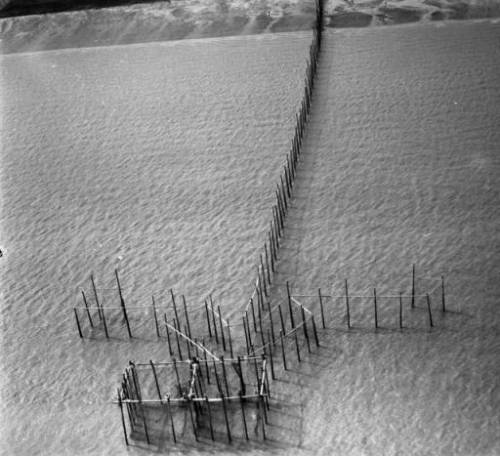
Alaska fish trap, Trading Bay, Cook Inlet, ca. 1948. Source: http://vilda.alaska.edu/cdm/singleitem/collection/cdmg2/id/6703/rec/47
It’s very reminiscent of the Comox examples (and BTW, I am led to believe the Comox fish trap study may be coming out soon….. ). This style of trap was adopted by the commercial industry and lots of huge examples are known, and for a while were apparently controversial. This is an interesting map showing the density of fishtraps extending from the shore in Ikatan Bay, SW Alaska. However, the one above seems pretty much hand-made and an example that is comparable in scale, size and style of the Comox ones.
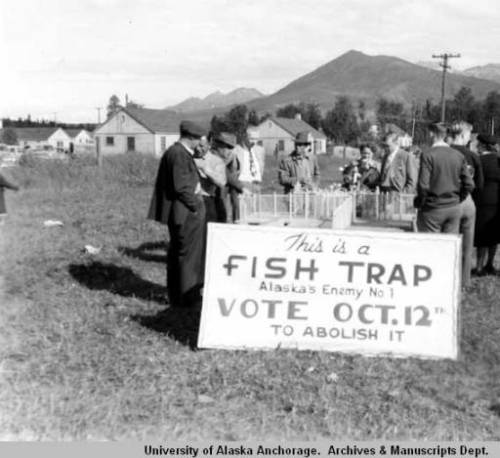
Fish Traps: Alaska’s Enemy Number One. Anchorage, ca. 1948. Ssource: http://vilda.alaska.edu/cdm/singleitem/collection/cdmg13/id/1930/rec/9
I don’t know much about the Alaskan situation, but traps and weirs were also banned in BC in the 19th century, as part of the colonial project to wrest control of the salmon fishery from First Nations. In the process, the advantages of weirs and traps – close monitoring of the run at the natal stream allowing selective harvest of actual returns – was lost.
I mentioned basketry traps, and while there are tons more pictures of interest to show, I’ll close with the one below – an amazing feat of the textile arts, you’ll agree.
![Title from caption. Handwritten note reads "Kwithluk fish trap [Kwethluk]." Alaska Native man and woman pose in front of a structure identified as a fish trap. Kwethluk, SW Alaska. Source: http://vilda.alaska.edu/cdm/singleitem/collection/cdmg11/id/12049/rec/25](https://qmackie.com/wp-content/uploads/2014/09/screen-shot-2014-09-30-at-10-39-32-pm.png?w=500&h=349)
Title from caption. Handwritten note reads “Kwithluk fish trap [Kwethluk].” Alaska Native man and woman pose in front of a structure identified as a fish trap. Kwethluk, SW Alaska. Source: http://vilda.alaska.edu/cdm/singleitem/collection/cdmg11/id/12049/rec/25

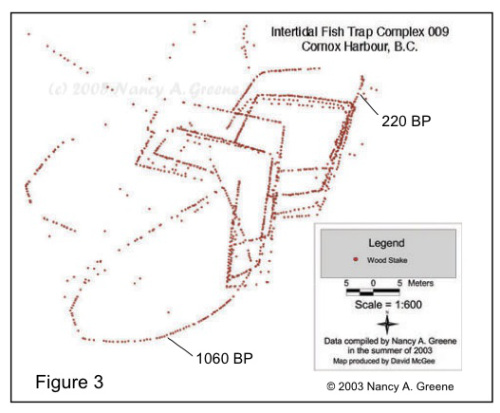

Interesting post. I recall from undergrad years a film shown in class of Netsilik Inuit using a weir to facilitate spearing of fish. I am pretty sure it was these two NFB films: http://bit.ly/1vv7nxC and http://bit.ly/1BA4XiQ which show many different activities including rebuilding parts of the weir prior to fishing, and related camp activities, etc. A very interesting reconstruction from 1967.
LikeLike
Thanks, those Netsilik videos are cool especially as you say the weir bits.
LikeLike
Anyone know what the function of the stone weir and second pool was? I wonder if it helped to raise the water level, or slow the water flowing through the wood weir? Obviously some effort went into constructing it and the cribbing across the side channel, just downstream of the wood weir. Also, any thoughts on the structure in the background of the second photo, along the stream? It seems to overhang the stream, like a platform.
LikeLike
In the 1970’s, most villages on or near the Yukon had diversion weirs and fish traps in the winter for Burbot. The Johnson River that flows into he Kusokwim River below Bethel has three villages and in the 197’s, each had a weir that crossed the river. They each had walk way and a opening in the center where dip nets were used catch hump back whitefish and Northern Pike.. These fish migrate in the spring and fall from huge, shallow lakes north of Kalskag, Alaska. I have heard that this population of hump back white fish has been badly damaged.
LikeLike
Hi Richard, Scott. Thanks for your comments.
Scott I’m not sure about that. It looks like racks and a small house close together, so possibly a smokehouse, and possibly not actually crossing the river or overhanging it? It’s a little hard to resolve. It looks like a trail leading to it to the right so possibly a footbridge as well?
I’ve always thought the pools were to induce a sort of complacency in the fish. If we are talking salmon, anyway, they like to rest in the slower water. Having the faster water through the gap and then a space before the wood weir – well, it seems consistent with the psychology of fish to do a quick burst through the gap and then rest in the deeper pool – meanwhile the wooden weir stops them from proceeding. In the meantime then they are vulnerable to dipnets. I don’t know that that’s what’s happening in the top two pictures but it makes sense to me. However, I don’t have a lot of direct, knowledge about this stuff. Archaeologically though I’ve seen a lot of weirs that seem to include pools or loose pens in which the fish are kind of encouraged to just mill around in circles which being creatures of inherent dispositions, they might just do indefinitely.
Richard – interesting info about the different species, thanks.
LikeLike
Pingback: Around the Archaeology Blog-o-sphere Digest #5 | Doug's Archaeology
This is off the geographic grid, but a really amazing excavation is happening in Denmark at a 5000 year old fish trap where they’ve found two sets of footprints next to fish weirs http://www.thehistoryblog.com/archives/33450
the working interpretation seems to be that the trap may have been in the process of being dismantled prior to a storm coming in. Great context and other interesting elements in amidst the weir – animal crania as ritual offerings!
I wonder if footprints have ever been found in the intertidal in BC, perhaps next to the similarly ancient Glenrose cannery fishtraps?
http://www.jstor.org/stable/41102855
LikeLike
The fish traps banned after statehood in Alaska were large very commercial fish traps own by large canneries such a as Libby and Red Salmon. SE and South Central Alaska they very badly damaged the salmon population and derived many commercial fishermen from a decent living. Many of the fisherman in SE lost their livelihood and subsistence food due to the effects of these large traps. Subsistence fish traps are still in wide use by Alaska Natives but in coastal areas and large rivers they have been replaced by set and drift gillnets. Black fish, whitefish and burbot are the main fish caught in traditional fish traps. Weirs are used in combination single and double pole dip nets. Salmon are generally regulated by the Federal government and based on escapement and international treaty. King salmon fishing has been poor in western Alaska the past few years and must be shared with subsistence users in Canada. Chums have a few bad years but have turned around. All the rest of the fish populations.are thriving. The Yupik do not waste time fishing in areas where the fish population has temporarily declined. Leisters no longer appear to be used, although simple gigs and gaffs are. Gigs are still used in combination with a jigged lure. Smelt and tom cods are often jigged or snagged with a bare, shiny hook. In western Alaska, the Alaska Fish and Game was and continues to be ignored by individuals intent upon feeding their families. Spring water fowl hunting and the hunting of swans was banned under the international migratory bird treaty with Mexico and Canada. However, the Feds realized it was unenforceable. So we hunt in the spring while there is still plenty of snow and ice. Seal hunting is preferred but when the wind is out of the west, the loose ice bocks the access to open water.,. Geese, sea ducks and swans then feed our families. We also gather goose eggs and drive the flightless geese into nets in June. and July.
LikeLike
I wrote a traditional cultural property document for a fish site similar to the one depicted at Trading Bay for the Port of Anchorage Expansion and the Knik Arm Crossing project when I worked for Stephen R. Braund & Associates.
The device is called a tanik’edi in Dena’ina (Cornelius Osgood described them in The Tanaina Indians, Yale reprint in 1967) and it appears to be an adaptation of a riverine fish fence trap that combines the purposes of a dipnetting platform and a weir, modified by the advent of relatively inexpensive commercial gill nets and the decline in Native labor availability in Cook Inlet resulting from a series of epidemics and social stress in the region.
The fences take advantage of salmon returning close to shore to natal streams; TEK indicated that King salmon would swim to Cairn Point where a whirlpool formed at the tides and turn to follow the shore to Ship Creek to spawn. Dena’ina would build the fence out at low tide, with the spacing of the fence boards allowing small fish to pass; large fish would follow along the fence and be netted by dipnetters along the length of the fence. Not quite Celilo Falls but the most important single resource of Cook Inlet.
Camp was at springs at the base of the bluffs and included a residential structure, steam, and smokehouse. Over time these indigenous structures adopted commercial replacements; gill nets strung up on the fence poles, canvas tents replacing summer houses, and access by road replacing boat travel from winter villages. All this was forced underground with the construction of the Army base at the top of the hill, as were other Anchorage fish camps using Tanik’edi structures at Woronzof and Point Possession.
LikeLike
Erik, many thanks for this detailed and informative comment.
The point about these historical photos and ethnographic accounts being situated in a colonial/transformative setting is particularly well-taken.
LikeLike